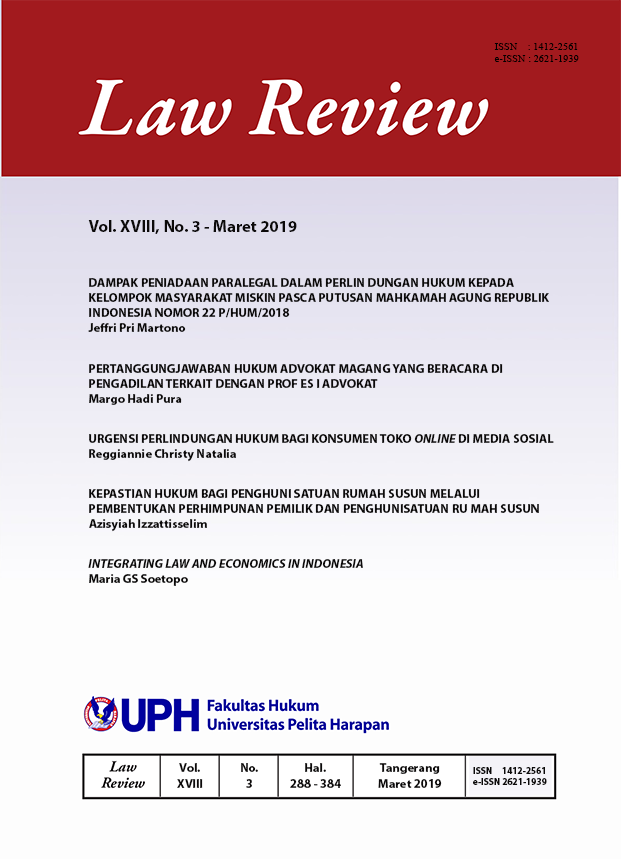INTEGRATING LAW AND ECONOMICS IN INDONESIA
DOI:
https://doi.org/10.19166/lr.v18i3.1493Kata Kunci:
economic analysis of law, law and economics, law and developmentAbstrak
The application of “Law and Economics” dates back to 1,500 years ago, and has been applied in many eras. In the 20thCentury, Ronald Coase, pioneered the study of law and economics which was further elaborated by Richard Posner with a new synonimously interchangeable terminology,Economic Analysis of Law (EAL). EAL uses an economic method to analyze how changes in the law affect the allocation and distribution of wealth in society. This has provided a foundation of a market approach to the legal decision-making process through the use of varioustechniques including Cost Benefit Analysis (CBA), Cost Effective Analysis (CEA), and Regulatory Impact Assessment (RIA). As one of the most commonly used techniques, CBA quantifies the objectives of the law with an ultimate goal of maximizing benefits and minimizing costs. It is an analytical tool which searches for variables to indicate economic efficiency. As the legislative drafting process in Indonesia lacks a concrete and measured analytical tool, embedding the law and economics methodology within the regulatory making mechanism can provide more effective laws and regulations. As the world experiences uncertainties during the globalization era, it is imperative for any country to integrate law and economics in the regulatory governance framework to reach a common goal: the maximization of social welfare as enshrined in Article 33 of the 1945 Indonesian Constitution.Referensi
Regulations
Indonesian Constitution of 1945.
Law No. 12 Year 2011 concerning Making Rules
Books
Adler, Matthew D., Eric A. Posner. Cost-Benefit Analysis: Legal, Economic, and Philosophical Perspectives. Chicago, London: The University of Chicago Press. 2001.
Bingham, Tom. The Rule of Law. London: Penguin Books. 2010.
Conboy, Maria G.S. Soetopo. Indonesia Getting Its Second Wind: Law and Economics for Welfare Maximization. Jakarta: Gramedia Pustaka Utama. 2015.
Elliot, Mark, Administrative Law: Text and Materials, ed. Jack Beatson, Martin Matthews, 4th Edition. New York: Oxford University Press. 2011.
Evensky, Jerry. Adam Smith’s Moral Philosophy: A Historical and Contemporary Perspective on Market, Law, Ethics, and Culture. New York: Cambridge University Press. 2005.
Friedman, Jeffrey. What Caused The Financial Crisis. Philadelphia: University of Pennsylvania Press. 2011.
Fitzpatrick, Daniel. “Culture, Ideology and Human Rights: The Case of Indonesia’s Code for Criminal Procedure”. Indonesia Law and Society, ed. Tim Lindsey. Singapore: The Federation Press. 2008.
Jr., Oliver Wendell Holmes. The Path of The Law and Its Influence: The Legacy of Oliver Wendell Holmes, Jr., ed. Steven J. Burton. New York: Cambridge University Press. 2000.
Kolb, Robert W.. Lessons form The Financial Crisis: Causes, Consequences and Our Economic Future. New Jersey: John Wilet & Sons, Inc. 2011.
Krugman, Paul. Currency Crisis. Chicago, London: The University of Chicago Press. 2000.
Marciano, Alain. Law and Economics: A Reader. London, New York: Routledge. 2009.
McCoubrey, Hilaire. Legal Theory. Hampshire, New York: Palgrave Macmillan. 1999.
Mercuro, Nicholas, Steven G. Medema. Economics and The Law: from Posner to Post-Modernism. New Jersey, West Sussex: Princeton University Press. 1997.
Mulgan, Tim. Understanding Utilitarianism. Stocksfield: Acumen. 2007.
Napolitano, Giulio. The Role of The State in (And After) The Financial Crisis: A New Challenges for Administrative Law. Yale Law School: May 2009.
Posner, Richard A.. Economic Analysis of Law. New York: Wolter Kluwer & Business, Aspen Publisher. 2011.
Posner, Richard A.. The Problem of Jurisprudence. Cambridge, Massachusetts, London: Harvard University Press. 1990.
Wright, Robert E.. Bailouts: Public Money, Private Profit. New York: Columbia University Press. 2010.
Paper
Alawode, Abayomi A., Mohammed Al Sade. “What is Financial Stability”. Central Bank of Bahrain Financial Stability Paper Series No. 1. March 2008.
Unduhan
Diterbitkan
Cara Mengutip
Terbitan
Bagian
Lisensi
Authors who publish with this journal agree to the following terms:
1) Authors retain copyright and grant the journal right of first publication with the work simultaneously licensed under a Creative Commons Attribution License (CC-BY-SA 4.0) that allows others to share the work with an acknowledgement of the work's authorship and initial publication in this journal.
2) Authors are able to enter into separate, additional contractual arrangements for the non-exclusive distribution of the journal's published version of the work (e.g., post it to an institutional repository or publish it in a book), with an acknowledgement of its initial publication in this journal.
3) Authors are permitted and encouraged to post their work online (e.g., in institutional repositories or on their website). The final published PDF should be used and bibliographic details that credit the publication in this journal should be included.





